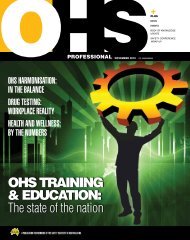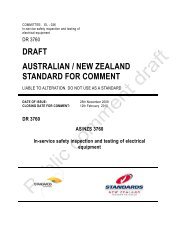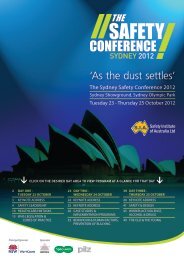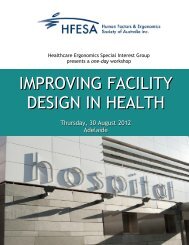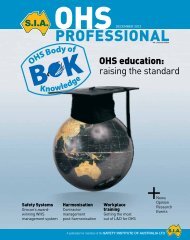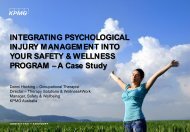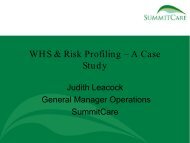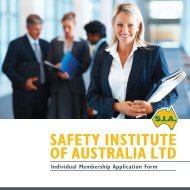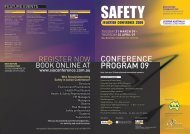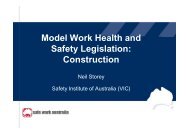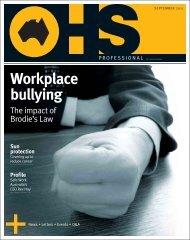Defence: overcoming its âcan Doâ culture unsW kills safety anD risk ...
Defence: overcoming its âcan Doâ culture unsW kills safety anD risk ...
Defence: overcoming its âcan Doâ culture unsW kills safety anD risk ...
Create successful ePaper yourself
Turn your PDF publications into a flip-book with our unique Google optimized e-Paper software.
Book NoW To TAkE AdvANTAgE of early bird savingsHEAR fRom ovER 70 AUSTRALIAnAnD InTERnATIonAL SPEAkERSAnD kEEP AbREAST of THE LATESTInfoRmATIon foR YoUR InDUSTRYIncLUDIng:hear the latest on harmonisationGain insights from industry leadersexperience best practice examplesnetwork with colleagues and clientsTUESDAY 20 APRIL 2010 >THURSDAY 22 APRIL 2010MelbourneConvenTionCenTrePresented bySaFeTy inSTiTuTe oF auSTralia(viCToriA divisioN) iNCwitH tHe suPPort ofmajor sPonsorHeld in conjunction witHTrade ShowTuesday 20 - Thursday 22 April 2010Melbourne Exhibition CentreFull details and online registration at sia.org.au
neWsohs executive salaries fall $59k6Ending two year’s of a steady rise in salaries, this year <strong>safety</strong>executives’ remuneration packages have declined by an averageof $59,000, according to Victorian recruitment firm, SafeSearch.“The 2010 SafeSearch annual salary survey demonstrates that whentimes get tough, talk of <strong>safety</strong> being a core part of business may bethrown aside,” managing director of SafeSearch, Julie Honore says.The research indicated that remuneration packages for ageneral manager of <strong>safety</strong> fell 21 per cent from $280,000 to$221,000.The 2010 annual salary survey collected data from 59companies and 350 respondents, primarily drawn from the ASX200, according to SafeSearch.Safety officers however saw a slight uptick of 6 per cent,with average packages increasing from $73,000 to $77,000.Queensland officers appeared to be in the best position inAustralia. Salaries rose 26 per cent.A note to <strong>safety</strong> officers that lack qualifications was that demandcontinues for “higher formal qualifications”, according Honore.The company’s last survey had shown that salaries rose 10per cent for two years running. It warned in <strong>its</strong> last survey that itexpected salary increases to flatten off as the market softened.“The 2010 SafeSearch annual salary survey demonstrates thatwhen times get tough, talk of <strong>safety</strong> being a core part of businessmay be thrown aside,” Honore says. “When cost-cutting kicks in,companies that only pay lip service to <strong>safety</strong> readily make <strong>safety</strong>roles redundant, particularly at the general manager level.”But good times may be ahead, said Honore.“Western Australia and Queensland are already starting toexperience s<strong>kills</strong> shortages and it won’t be long before otherstates follow. Companies anticipating salary hikes, particularlyin the highly-paid resource sector, have tied their people in tolong-term incentives.”OHS PrOfeSSiOnaL ISSUE 3 | MARCH 2010vale katrina Wakeling, cpmsia.The Safety Institute of Australia lost one <strong>its</strong> brightest youngmembers with the sudden passing in December, 2009 ofKatrina Wakeling, CPMSIA.Katrina was an enthusiastic and professional practitioner,much admired and respected by those with whom sheworked and her peers in the Institute. She was a regularparticipant in activities and events in the Victoria Divisionand we will miss her stimulating and informed contribution tothe discipline of OHS.We are currently preparing an article about Katrina forpublication on the SIA website and in the next edition ofthis magazine. Katrina’s mother is also preparing a book ofmemories to pass on to Katrina’s 9 month old son Lewiswhen he is older. We would welcome contributions fromany member who knew or worked with Katrina. Pleasecontact the SIA’s National Office if you would like to subm<strong>its</strong>omething for inclusion in the SIA article or the family’smemory book.We are grateful for the contribution this truly remarkableyoung woman made to the Institute and the profession. ValeKatrina.sue pilkingtonpresident – victoria Division (inc)<strong>safety</strong> institute of australia
ailways and roads to get new <strong>safety</strong> strategyA plan is in place to develop a strategyto improve the <strong>safety</strong> of railway levelcrossings, which claims 37 lives each year.The strategy is being developed bythe Australian Transport Council, whichhas planned to release a draft of it byDecember this year.Key plans include devising <strong>risk</strong>management strategies for Australia’s8,900 rail level crossings, trialling new alerttechnologies for road users, data capturefor incidents, and a nationally consistenteducation and enforcement plan.Western Australia (WA), which has 1,251level crossings, will play a key role in theprogram, and has recruited former WestCoast Eagles AFL star David Wirrpunda asan ambassador for the new National RoadSafety Council.“I have a personal interest in road <strong>safety</strong>and I have seen the devastation fatal andserious road crashes have on families andcommunities,” Wirrpanda said.WA will tip $20 million into rail levelcrossings in 2010, according to WAMinister for Transport Simon O’Brien, butheadded that it was vital to have a nationalapproach.The National Transport Commission (NTC)has welcomed the move. “Reducing crashesat railway level crossings is essential toimproving the <strong>safety</strong> of Australia’s road andrail networks,” NTC’s senior manager of <strong>safety</strong>Dr Jeff Potter said.ISSUE 3 | MARCH 2010 OHS PrOfeSSiOnaL7
neWsWestern australia on crane <strong>safety</strong> driveWestern Australia’s WorkSafe this month kicked off acrane inspection program due to ongoing concerns overmechanical failure.“There are literally thousands of these types of cranes inuse across the State – in fact, most factories, warehousesand workshops have at least one of these cranes,” saidWorkSafe WA Commissioner Nina Lynhe.“WorkSafe inspectors have encountered many mechanicalfailures with these cranes over the years, and felt thatthis warranted a program to check as many of them aspossible.”A potential <strong>risk</strong> in WA is the age of cranes, according toWorkSafe WA’s inspectors.“Our inspectors want to make sure that they are beingproperly maintained so they do not fail and cause an injury,”said Lynhe.Inspections will be on the look out for unregistered cranedesigns, crane modifications, that access channels aresafe, maintenance and inspection record keeping, operatorlicensing, and lifting gear such as chains and slings.“Under WA’s occupational <strong>safety</strong> and health laws,employers have a responsibility to properly maintain items ofplant in the workplace,” Lyhne said.“Employers also have an obligation to ensure thesecranes are being maintained, inspected and operated inaccordance with the manufacturer’s instructions, but insome cases the manufacturer is no longer in existence andAustralian standards then must be followed.”8Worksafe vic launches bullying campaignWorkSafe Victoria is offering free workshops to for download, to raise consciousness at thebusinesses that want to know how to manage workplace.the problem of bullying.Its guide provides practical advice on howThe regulator says <strong>its</strong> research shows to prevent and respond to bullying at work,that 14 per cent of the Victorian workforce and provides a reminder of employer andexperience bullying.employee obligations under law.“Bullying is repeated, unreasonableAdditional information it has made availablebehaviour directed to an employee or group includes an employer checklist for managingof employees that creates a <strong>risk</strong> to health bullying, a bullying <strong>risk</strong> indicator, and adviceand <strong>safety</strong>,” it said.for those that believe they are the victim ofIt has made available <strong>its</strong> bullying poster bullying.OHS PrOfeSSiOnaL ISSUE 3 | MARCH 2010
another victorian worker diesVictoria saw <strong>its</strong> sixth fatality within six months killed at work in Victoria - almost twice thein late February, the latest a 26 year old worker 16 that occurred than during <strong>its</strong> 2007/08who was believed to have been electrocuted. financial year. “This is an intolerable numberThe incident occurred apparently inand one that we do not have to repeat,” saidthe absence of colleagues, according to WorkSafe’s Acting Director of Health andWorkSafe Victoria.Safety, Stan Krpan.“The man was running an electric press “It takes a commitment from the heads ofused to mould rubber gaskets and seals and companies, their managers and supervisorswas found by workmates around 11.30am,” it through the workforce to make it happen.”said in a statement.“Simple measures make a real differenceWorkSafe is investigating whether he had not just in preventing deaths but the manydied as a result of an electric shock. It has serious injuries which have life-changingplace <strong>safety</strong> improvement notices on the consequences for individuals and theirsuspect machine and another similar one that families.”was next to it.In the six months to December 2009,WorkSafe said it was the fourth fatality in Victoria saw 14 work related deaths in the and2010, which was down on last year’s six at equally as important. During the year 72 lifethe same period. Last year 30 people were threatening incidents were recorded.sia eventsRethinking Safety: It’s not Rocket Science, it’s Much HarderWhen: 19:00 - 21:30, Monday 19 April 2010Where: BMW The Edge at Federation Square, MelbourneAbout: Professor Patrick Hudson from the Netherland’s Delft Universityof Technology, Department of Safety Science will share his new vision for<strong>safety</strong> - one where it becomes possible for professionals to do dangerousbut profitable things without suffering the potential adverse consequencesbecause they have a more realistic and well-founded understanding of whatit means to be safe.Book online via the Safety In Action 2010 Conferenceregistration process or contact the SIA National Office on 03 8336 1995 ornatadmin@sia.org.au for assistance.Safety In Action Conference 2010When: Tuesday 20 April to Thursday 22 April 2010Where: Melbourne Convention CentreAbout: Hear the latest on harmonisation, gain insights from industry leaders,learn best practice examples, and network with colleagues and clients atAustralia’s largest <strong>safety</strong> conference. Keynote speakers include Captain TerryVickers, Executive Director Skytraders, Antarctic Aviation Division, AustralianNational University Professor of Sociology Andrew Hopkins, and WorkSafeVictoria’s Acting Executive Director Stan Krpac.Safety In Action Trade Show 2010When: Tuesday 20 April to Thursday 22 April 2010Where: New Melbourne Convention CentreAbout: Safety In Action and Melbourne Materials Handling 2010 feature the verylatest <strong>safety</strong> products and services showcasing: installation systems, fire andemergency training and fire retardant garments and attracting architects, facilitymanagers, specifiers, security consultants and building managers. Otherfeatures at Safety In Action include Corporate Health, Building & Height Safety,Training & Technology and Electrical Safety .Register online at ww.sia.org.auSlips, Trips & FallsDid you know that 18% of workplace injuries are caused by Slips, Trips and Falls?Prevent these injuries with Brady’s wide range of Safety Products in 8 Steps.1Mark Aisles & Passageways ...................................................2Provide Traction on Slippery Surfaces ...............................................................................................3Improve Safety on Stairs ..........................4Mark Emergency Evacuation Routes ...........................................................5Post Safety Signage & Labelling ..........................................................................................................6Warn of Temporary Hazards ...........................................7Inspect Scaffolds & Ladders ......................................................................8Control and Clean Oil & Spills ...........................................................................OHS_MAR10For more information or to request a FREE on-site demo, please contact Brady Customer Service or your local distributor.Freecall Aus: 1800 620 816Website: www.bradyaust.com.auISSUE 3 | MARCH 2010 OHS PrOfeSSiOnaL 9
eDitorialthe kirk Decision:ohsparticulars necessary10stephanie vass, partner and Justinle blond, associate employmentrelations, piper aldermanOHS PrOfeSSiOnaL ISSUE 3 | MARCH 2010the High Court of Australia recently handed down a landmarkdecision in the case of Kirk v Industrial RelationsCommission of New South Wales; Kirk Group HoldingsPty Ltd v Work Cover Authority of New South Wales (InspectorChilds) [2010] HCA 1 (Kirk v NSW IRC) which criticisedthe way in which WorkCover formulates charges under the OccupationalHealth and Safety Act 1983 (NSW) (the OHS Act).It is significant because the High Court also criticised theNSW Industrial Relations Court’s “settled” view that it was notnecessary for the prosecution in such a case to demonstrate withparticularity what specific measures the defendant(s) shouldhave taken to ensure the <strong>safety</strong> of persons in the workplace.the factsMr Graham Palmer was employed by Kirk Holdings Pty Limitedas the manager of a hobby farm near Picton in the State ofNew South Wales. Mr Kirk, who was the director of the Company,did not have any experience in farming and did not have aday-to-day role in the operation of the farm.Mr Palmer who had run a large property of his own and whowas considered to be a very competent person, took all responsibilityin the running of the Kirk farm, including the implementationof <strong>safety</strong> measures. On the recommendation of MrPalmer, the Company purchased an All-Terrain vehicle (ATV).On 28 March 2001, when Mr Palmer was towing threelengths of steel using the ATV, he left a purpose-built road anddrove overland down the side of a hill. The ATV overturnedand Mr Palmer was killed.Mr Kirk and the Company were charged with offences undersections 15(1) and 16(1) of the OHS Act for failing to ensurethe health and <strong>safety</strong> of Mr Palmer and the contractors workingon the farm. Mr Kirk was charged because he was concernedwith the management of the Company.Mr Kirk and the Company pleaded not guilty to the charges,relying on the defence in section 53(a) of the Act that it was not‘reasonably practicable’ for Mr Kirk and the Company to complywith their duties, since it was unforeseeable that Mr Palmerwould ride down the side of the hill as he did. Justice Walton ofthe NSW IRC found both Mr Kirk and the Company guilty ofthe offences, and accordingly fined Mr Kirk and the Company$11,000 and $110,000 respectively.Mr Kirk and the Company sought and were granted specialleave to appeal to the High Court.the high courtThe High Court unanimously quashed the convictions of MrKirk and the Company. In <strong>its</strong> reasoning as to the invalidity ofthe convictions, the High Court addressed several key issuesregarding the interpretation of the duties arising under the Actand the way in which the matter had been prosecuted.The charges against Mr Kirk and the Company did not identifywhat measures should have been taken to prevent the <strong>risk</strong>of injury to Mr Palmer. In addition, aside from the failure toensure that only trained people used the ATV, the charges didnot specify the grounds in which Mr Kirk and the Company hadfailed to ensure Mr Palmer’s health and <strong>safety</strong>.The High Court found that these deficiencies in the particularswere unfair because it deprived Mr Kirk and the Companyfrom ‘knowing what measures they had to prove were not reasonablypracticable’. This prevented Mr Kirk and the Companyfrom properly understanding the case against them.The High Court was required to judge the reasonableness of
eDitorial“the high court’s decision represents a fundamental shift of powerin the nsW system, and returns the previous unbalanced ohs lawsback into line with that in other states”any precautions taken by Mr Kirk and the Company with thebenefit of hindsight. The High Court rejected that the obligationshould be interpreted with the balance of hindsight. It held thatthe provisions of the OHS Act were not intended to operate ina way which required an employer to establish that there wasno reasonably practicable measures, of any kind, which couldhave addressed the <strong>risk</strong> in order to defend a prosecution. TheHigh Court commented that if considered in that manner, it wasalways possible to think of something further that could havebeen done.Accordingly, the High Court found that WorkCover failed togive proper particulars of the alleged offence committed by MrKirk and the Company. In doing so, the High Court overturneda long line of case law (notably in NSW and Queensland) whichheld that, where the onus of proof to establish a defence is onthe employer, the regulator is not required to particularise whatit alleges the defendant should have done to prevent the breach.The High Court further rejected the previously accepted principlethat the absolute nature of the obligation meant that theprosecution must only prove that a <strong>risk</strong> existed and that it wasnot eliminated by the employer. The High Court said that theprovisions relating to offences and defences in the OHS Actwere not intended to operate this way, that is:“……. it is necessary for an employer to identify the <strong>risk</strong>present in the workplace and to address them, in order to fulfilthe obligations imposed by ss 15 and 16. It is also necessary forthe prosecutor to identify the measures which should have beentaken. If a <strong>risk</strong> was or is present, the question is – what actionon the part of the employer was or is required to address it?”Therefore, the High Court found that WorkCover had failedto identify what Mr Kirk and the Company could have done toprevent the incident.Justice Heydon made significant comments in relation to thesupervisory obligations of an employer with an experienced employeewho has been reckless:“It is absurd to have prosecuted the owner of a farm and <strong>its</strong>principal on the ground that the principal had failed properly toensure the health, <strong>safety</strong>, and welfare of his manager, who wasa man of optimum skill and experience – skill and experiencemuch greater than his own – and a man whose conduct in drivingstraight down the side of a hill instead of on a formed andsafe road was inexplicably reckless”.conclusionThe High Court’s decision represents a fundamental shiftof power in the NSW system, and returns the previous unbalancedOHS laws back into line with that in other States.The decision will impact on the way in which prosecutionsare commenced. The WorkCover’s proceedings againstemployers for a breach of the OHS Act will now be requiredto specify not only the ‘<strong>risk</strong>’ which gave rise tothe incident but also what reasonably practicable measuresan employer should have taken to prevent an accident orinjury.The Kirk v NSW IRC decision will also have implications onthe prosecution of directors and mangers and the responsibilitiesof these people in their roles. The decision will lead the way formore clarity by WorkCover in such prosecutions.ISSUE 3 | MARCH 2010 OHS PrOfeSSiOnaL 11
is fatiguemining-construction’shidden killer?is fatigue being overlooked as the underlyingcause of accidents on major construction sites?One researcher believes it is, and she suspectsthe problem is worse for remote australianconstruction workers12by liam tungOHS PrOfeSSiOnaL ISSUE 3 | MARCH 2010in 2006, when University of Sydney researcher MargaretChan first asked ex-patriot executives at a well-knownChina-based oil-processing joint venture what was thecause of accidents at <strong>its</strong> China-based facility, she was toldthat workers couldn’t read <strong>safety</strong> signs, and therefore didn’tfollow <strong>safety</strong> procedures.The conclusion was, in China’s context, understandable.The workers predominantly came from rural China, which,given the country’s ethnic and linguistic diversity, meant thatfew could understand the local languages of the two operations- Mandarin and Cantonese since <strong>its</strong> operations werebased in Guangzhou (in China’s south) and Shanghai.“When I asked the expats what they thought were the main<strong>risk</strong>s,” says Chan, “they said these people are migrant workers:they cannot read <strong>safety</strong> signs, and they don’t know about OHS.Their belief was that if we train them - provide a carrotand stick approach - it will solve the problem.”Chan took note of their conclusions but also questioned the decisivenessof their answer. Her question to the expats was the precursorto a survey that, according to Chan, delivered surprising results.What she didn’t know was that after asking a sample ofworkers, <strong>safety</strong> managers, and executives in a survey toidentify one <strong>risk</strong> out of a possible 290 that she had listed,the unanimous answer - across both operations - was fatigue.Seventy-eight per cent had identified fatigue as the top<strong>risk</strong>. “I didn’t think this was the issue that would come outon top,” she says. “I concluded this is a big issue.”Chan’s exploration of fatigue within large scale constructionbegan in 2006 and has since canvassed four major siteswithin China as part of a PhD within the University of Sydney’sFaculty of Engineering and Information Technologies.Chan was granted over $100,000 by the Federal Governmentto conduct the research, and the organisation that wasthe subject of the study agreed on the basis that it was at nocost to it, while her findings could provide insight into <strong>its</strong> operations.It was the first time a PhD student had been grantedsuch access to a Chinese operation of this scale.And while she openly concedes that China has lower<strong>safety</strong> standards than Australia, local operations, including amajor Victorian project underway and local mining giants inWestern Australia, are paying attention.
eDitorialthe alcohol effectChan is not the first to identify fatigue as a major <strong>risk</strong> factor inthe use of heavy machinery. Indeed, when she discovered thatrespondents had, in contrast to the executives’ assumptions, identifiedit has the leading <strong>risk</strong> factor, she turned to Australia’s preeminentexpert in the field, Professor Drew Dawson, director atthe University of South Australia’s Centre for Sleep Research.“I asked him how would you interpret the results, what arethe variables, and what are the consequences [of the findings],”says Chan. “He’s the one that mentioned the relationshipbetween fatigue and blood alcohol levels.”Dawson had been working on a method to calculate theeffect of staying awake on a person’s mental performance.His calculations indicated that staying awake for 17 hoursis equivalent to having a blood alcohol level of 0.05, whichdoubles to .01 at 21 hours.But while Chan could draw inferences from this on the useof machinery at construction sites, her own research indicatedfatigue’s effects could have much wider consequences, inparticular at remote construction sites, typical of Australianmining regions.Respondents to Chan’s survey - which covered near or actualaccidents as well as the use of personal protective equipment- were asked to leave their mobile phone numbers onthe response form (but not their names, which enabled ananonymous follow up call).“Once I got the results, then I went out to identify thepeople who chose fatigue as the lead <strong>risk</strong>, and then (via aphone call) I found out who had a near miss or an accident,”she says.The second stage of the research involved data mining theresults, which says Chan, revealed a strong link between fatigueand the failure to use personal protective equipment(PPE).“The data mining analysis showed that fatigue is highlyassociated with improper use of PPE. It turned out that theprobability of not wearing it is high when fatigued,” shesays, deducing that staff tended to either forget or skip basic<strong>safety</strong> procedures when stressed.This could have a significant impact on the analysis ofaccidents that occur on the workplace, in particular, as ithad on one of the sites she had been researching, wherea worker had been killed when the crane he had been operatinghad toppled over. It was impossible to identifywhether the operator had not followed the correct procedures,but nor was it possible to identify whether fatigueplayed any role.One of the issues that Chan noticed in relation to <strong>safety</strong>during her research was that many organisations viewed<strong>safety</strong> as a purely procedural matter: if staff follow the correctprocedures, accidents won’t happen was the view shefound.“I say if you don’t address fatigue, even if you send themto training, they might not follow the correct procedures,”says Chan.While her research to date has only covered fatigue atoperations where heavy construction machinery is in frequentuse, she intends to next look into fatigue’s underlyingcauses, which is also why she believes her findings are sorelevant to Australia.“i say if you don’taddress fatigue,even if you sendthem to training,they might notfollow the correctprocedures”ISSUE 3 | MARCH 2010 OHS PrOfeSSiOnaL 13
issues<strong>unsW</strong>’s <strong>risk</strong> and <strong>safety</strong> school closure:lacks “impact”the University of new South Wales (UnSW) hassounded the School of <strong>risk</strong> and Safety Science(SrSS) death knell, and while there is seriousconcern over <strong>its</strong> loss, the university says purescience will deliver a greater impact than itcould, writes Liam tung16OHS PrOfeSSiOnaL ISSUE 3 | MARCH 2010
issuesby 10 December 2010 UNSW expects to have completed<strong>its</strong> closure of the school, leaving some 250 students out ofthe course they had signed up to, but perhaps even moreworrying is the loss of what some believe is the only institutionin Australia that deals with a key area of workplace <strong>risk</strong>:chemical hazards.UNSW announced <strong>its</strong> decision late last year to “disestablish”the SRSS. The closure, according to it, was made on the basisof findings by a “panel of international experts” which had conducteda review of the Faculty of Science in 2008.The review, previously accessible on UNSW’s website, hassince been locked to the public, and outlines the university’sstrategic objectives behind ending the school.The panel recommended the Faculty of Science, withinwhich SRSS is housed, focus <strong>its</strong> resources on core subjectssuch as maths, physics, chemistry and psychology. SRSS onthe other hand falls under the now seemingly unpopular labelof “applied science”.Its research areas include fire and explosion <strong>risk</strong>s, health<strong>risk</strong> management, and toxicology, which dovetails with severalsectors, including health, food and transportation industries. Interms of training, it also offered applied ergonomics related tothe prevention of slip injuries, infection control, management ofmajor hazard facilities, and handling of cytotoxic drugs.Programs at the level offered by SRSS are an endangeredspecies in Australia, according to Jeff Simpson, a Melbournebasedregulatory affairs and chemical hazard classification consultantfor HazTech Environmental.Such schools are fragile too. The survival of such institutionswithin Australia has depended on the drive of a single person- in the case UNSW’s SRSS, Dr Chris Winder, a professor inapplied toxicology who is recognised as one of Australia’s topin the field.“In our field,” said Simpson, “the work being done by DrWinder is that the bleeding edge of training at a tertiary levelstandard. There is no other course.”A comparable course did exist at Victoria’s Deakin University,according to Simpson, however that was closed after <strong>its</strong>head was poached by industry, leaving SRSS as the only offeringat this level.“I’m appalled that we can allow this to happen,” said Simpson.“The university is closing the one and only place of excellencein this field.”Simpson said he has written a letter to every singlemember of parliament in Australia - except for the Prime“We earn more than we spend. the decision seems to be that if thefaculty [of science] can’t get rid of maths, psychology and physics,then let’s get rid of <strong>safety</strong>”toxicology professor, Dr chris WinderMinister, Kevin Rudd - appealing for help in reversing theuniversity’s decision.“There are no alternative university schools in Australia atthis level, with such a relevant focus on research, teaching andtraining to fill our industry’s needs,” he said.closing srss: a bad financial move?Ironically, the timing of school’s closure has come under remarkablysimilar circumstances to <strong>its</strong> 1986 birth: at a time ofmajor regulatory change, this time triggered by the harmonisationof state and territory OHS laws, which amongst otherthings has included a review of the control of hazardous workplacechemicals.And while other institutions such as University of Queenslandappear to have capitalised on this, launching <strong>its</strong> OHS degreethis year, UNSW is not interested in the opportunity.UNSW has faced tough times in recent years. In 2006, theyear Dr Fred Hilmer was appointed vice chancellor, saw theuniversity’s $10 million operating loss turn to a $22 millionsurplus. But since then it has suffered consecutive losses withthat surplus vanishing, then ballooning into an $88 million lossby 2008.Hilmer, Fairfax’s former chief, has blamed the university’salumni component of <strong>its</strong> board for poor financial decisions, including<strong>its</strong> failed investment in Singapore. However, it appearsthat he has supported this strategic choice at the expense of theuniversity’s financial gain.Safety’s parent faculty, Science, is believed to have facedbudget overruns last year of about $3.5 million, howevercost-cutting has been denied by UNSW as the reason drivingSRSS’s closure.A spokesperson for the UNSW’s vice chancellor Hilmer latelast year told Fairfax newspaper, the Sydney Morning Herald,that the school’s closure was “not a matter of cutting budgets”for the Faculty of Science, and that the decision was “strategic”.At least on this point at least Winder agrees with the university:money is not the issue. In fact, if his figures are accurate,UNSW will lose money by closing SRSS, which last year generatedrevenues of $5 million.“The [SRSS] budget is 48 per cent of that, so the universitygets a fair chunk of that,” Winder told OHS Professional.So why is UNSW determined to kill the school?The school has faced a turbulent history at UNSW, whichhas over the years pushed to promote and perceive <strong>its</strong>elf as an“elite” university. This, according to Winder, appears to be thereason UNSW has made <strong>its</strong> decision.“The decision is political because the reasons they havegiven [for closing SRSS] are not valid. We earn more than wespend. The decision seems to be that if the faculty [of Science]can’t get rid of maths, psychology and physics, then let’s get ridof <strong>safety</strong>,” he said.SRSS has been shunted from faculty to faculty over the years.Initially placed within the Faculty of Engineering in 1986, itcontinued on p 18ISSUE 3 | MARCH 2010 OHS PrOfeSSiOnaL 17
continued from p 17later moved to the School of Applied Science, which was <strong>its</strong>elfdisestablished, resulting in Safety’s shift to the Faculty of Scienceand Technology. It too however was shut down in 2001,landing the School of Safety Science beneath the Faculty ofScience, from which it will soon be evicted.The Safety School’s last brush with “disestablishment” wasin 2003, three years prior to Hilmer’s 2006 appointment as vicechancellor. Minutes from a meeting by the university’s AcademicBoard reveal that it planned to recommend to the thenvice-chancellor to have it “disestablished”.An independent review however reversed the decision. Priorto <strong>its</strong> change of heart, the disestablishment strategy was similarto today’s: find alternative homes for portions it wants to keep.The only part of SRSS UNSW has kept is <strong>its</strong> Risk ManagementProgram which has landed a spot at Hilmer’s old haunt,the Australian School of Business (formerly the AustralianGraduate School of Management), which he headed up prior tohis stint at Fairfax. From 2011 the Risk Management Programwill become an ASB Masters of Risk Management, while otherparts will be blended into commerce.the review rigged for <strong>safety</strong>’s failureBut for the larger portion of SRSS, death is imminent and <strong>its</strong>seed was planted in the 2008 review: <strong>its</strong> scope effectively delivereda self-fulfilling outcome in terms of <strong>its</strong> findings and subsequentrecommendations for SRSS.While research, a strength of the Faculty of Science, fell wellwithin scope, Safety’s strengths - <strong>its</strong> standard compared to otherAustralian OHS degrees; <strong>its</strong> value to the community; and contributionsto, for example, WorkCover NSW’s health efforts -did not. It strengths were not even considered in <strong>its</strong> evaluation.“gross over-reliance is placed on experiential learning beingprovided by the employer in the occupational environment, caused bylack of available teaching resources”former srss student and now general manager of sydney-based <strong>safety</strong> engineering and technical services consultancy, ross underwood“We weren’t presented well. The review said our researchwasn’t very good and suggested it should be let go,” Windersaid. “But the review was on research only and didn’t evaluateteaching programs and the value to the community.”Former SRSS student and now general manager of SydneybasedSafety Engineering and Technical Services consultancy,Ross Underwood, agrees that there will be a significant loss tothe community.The real loss, he says, is the serious dent it will have onteaching OHS management and <strong>its</strong> capacity to address a worksystem that has a reactive approach to <strong>safety</strong>.“[The system] ensures that employees at workforce entryacross every vocational stratum - from unskilled to supervisor/manager level - have virtually no OHS s<strong>kills</strong> or knowledge untilthey find out what they need to know,” Underwood told OHSProfessional.“While the research function would be an important loss, thereal concern to me is the loss of teaching,” he said.“There is a pathetic lack of OHS management knowledge ...in management systems, in industry, commerce and governmentthroughout Australia and particularly in the most populousstate NSW.“Gross over-reliance is placed on experiential learning beingprovided by the employer in the occupational environment,caused by lack of available teaching resources.”Besides this, Underwood said the SRSS has been instrumentalin developing a new matrix on the incompatibility of chemicalsubstances - “a topic with widespread ramifications acrossmany applications and with relevance to vocational and public<strong>safety</strong>,” he said.UNSW’s recently appointed Dean of Science ProfessorMerlin Crossley however has brushed aside the immediate andpractical implications of the school’s closure.Crossley has firmly rebuffed an attempt by key a figure withinthe state’s regulator WorkCover NSW to have it reconsider<strong>its</strong> decision.A WorkCover executive had in December appealed to Crossleyon the basis that SRSS had provided health and <strong>safety</strong> surveillanceeducation to authorised medical practitioners, whichthe regulator viewed as a valuable contribution to the community,while <strong>its</strong> closure would be a major loss to expertise in fireand explosion hazards Australia-wide.Signalling the university’s determination to shut theschool, Crossley replied that “a firm decision has been madeto proceed with the disestablishment, with effect from 10December 2010.”“The university has had to prioritise <strong>its</strong> limited resources,”Crossley continued, “and is determined to channel those resourcesin the Faculty of Science in research areas that it perceiveswill have even wider and deeper impact in the long term.”Crossley’s opinion is that the “university, as a whole, willremain relevant to the NSW <strong>safety</strong> professional community”and he was confident it could work with WorkCover NSW inother ways.18OHS PrOfeSSiOnaL ISSUE 3 | MARCH 2010
eDitorialWorksafe vic’s prof<strong>its</strong>up, but deaths up toorising unemployment may have helped WorkSafeVictoria’s prof<strong>its</strong>, but fatalities in the state in the pastsix months are at an alarming 14by liam tungWhile WorkCover South Australia’s $1.3 billion ‘unfundedliability’ has been seized upon by the state’s oppositionas a key election platform, WorkSafe Victoria hasturned around <strong>its</strong> $1.42 billion loss into a $686 million profitfor the half 2009-10 financial year.The regulator and insurer released <strong>its</strong> half year results inearly March. WorkSafe Victoria has attributed <strong>its</strong> turn aroundto an improved investment market, and to falling workers’compensation claims, which were down from 10.8 to 10.32claims per thousand workers compared to the same periodlast year.Chairwoman Elana Ruben said the drop may have comeabout by increased unemployment in the state, saying that“reduced hours worked during the economic downturn maycrunch time for Queensland and SaOther states have yet to release half year financial results, however South Australia’s insurer andregulator has become a key plank in the state’s Liberal opposition leader Isobel Redmond WorkCoverreform strategy.Redmond has spearheaded <strong>its</strong> WorkCover campaign with <strong>its</strong> $1.3 billion “unfunded liability”, reportedin <strong>its</strong> half year results last year. WorkCover is expected to release updated figures at the end of March.Thanks to the financial crisis, all state regulators saw their financial positions erode, including WesternAustralia’s Workcover which saw $10 billion wiped off <strong>its</strong> prof<strong>its</strong> compared with <strong>its</strong> 2008 results, leaving itwith a $2 billion after-tax profit at the end of financial year 2009. Its outstanding liability however was just$29 million in contrast to SA’s.Queensland WorkCover’s “outstanding compensation liabilities” meanwhile had risen $450 million to$2.3 billion in the 2008-09 financial year, as <strong>its</strong> operating losses more than doubled to $569 million.It attributed <strong>its</strong> liabilities to the lodgement of common law claims and the the size of subsequentsettlements. The figures spooked Queensland enough to contract Deloitte to review <strong>its</strong> operations, whichidentified these claims as a major ongoing <strong>risk</strong>.WorkCover Queensland has projected that within six year <strong>its</strong> finances will need to support outstandingclaims liability levels of $6 billion, driven by common law claims.The difference for South Australia though was that <strong>its</strong> finances were seen as so bad that <strong>its</strong> chief JuliaDavison this January announced her resignation.The other, as far as the South Australia’s political climate goes, is that <strong>its</strong> average levy on employers is3 per cent - more than double Queensland, Victoria and Comcare’s rate.SA’s Redmond will use WorkCover’s financial woes to spearhead a thrift-conscious policy reformcampaign as part of a plan to reduce the average levy rate from 3 per cent to below 2 per cent.One of her key planks would be to boost self-insurer numbers - currently 40 per cent of all employers -by allowing franchise groups and industry associations to become self-insured, while it would introduce anew regulator to oversee WorkCover’s operations.have helped cut the injury claims rate”.Indeed Victoria saw a half a per cent rise in unemploymentbetween December 2008 to December 2009 to 5.2 per cent,while it has seen a significant rise in part time employment,according to the latest figures by the Australian Bureau ofStatistics.Ruben was also alarmed by Victoria’s “significant increasein work-related deaths with 14 work related fatalities” in thesix months to December 2009.“This is a shockingly high number and requires broadcommunity involvement if it is to be reduced,” she said.WorkSafe’s target in 2008/09 was “fewer than 16 deaths”,based on the previous year’s “historic low” of 16 fatalities.Unfortunately, according to Ruben, there have been fivemore fatalities since December, leaving it eight short of lastyear’s 27 fatalities, a year it saw 72 life threatening injuries.“Our system is set up to encourage prevention, enforce thelaw and support those who have been hurt, but the obligationbegins in every workplace to ensure employers, managers,supervisors and workers do what they can to build saferworkplaces,” said Ruben.The regulator and insurer’s financial boon has come as itkicked off a major TV advertising campaign last month torevitalise interest in <strong>its</strong> free health check-up offer which waslaunched to a mild response last year.“this is a shockingly high number andrequires broad community involvement if itis to be reduced”Worksafe chairwoman elana ruben on the state’s 14 workplace fatalitiesISSUE 3 | MARCH 2010 OHS PrOfeSSiOnaL 19
eDitorialohs harmonisation?is it a pushmi – pullyuin the making?as the nation moves towards theharmonisation of workplace health and<strong>safety</strong> laws across nine jurisdictions,the question remains: onceimplemented, will it stick and will itresult in truly harmonised regulationof OHS across the country? Or will theinterpretation and application of thelaws by separate jurisdictions result ina Dr Dolittle style pushmi – pullyu.20OHS PrOfeSSiOnaL ISSUE 3 | MARCH 2010
eDitorialWhen Julia Gillard spoke to a members at the insurance giant Allianz’sWorkers’ Compensation National Client Seminar in September lastyear she was under no illusion about the challenges that lie ahead.“If it was easy, it would have been done by now,” she said, quoting BarackObama who was facing his own battles to reform US healthcare.The workplace health and <strong>safety</strong> laws will consist of the model WorkplaceHealth and Safety Act, supported by model work health and <strong>safety</strong>Regulations and model Codes of Practice that can be readily adopted aroundAustralia. This requires each state and territory to pass their own laws thatmirror the model workplace health and <strong>safety</strong> laws and adopt them by December2011. Harmonisation, as Gillard noted, has been on Labor’s agendasince 1974.But with Western Australia’s decision to reserve “the right not to adopt[future] changes recommended” by the Workplace Relations MinisterialCouncil (WRMC), the road to harmonisation has already shown signs thatunification and consistency in the future development and application of themodel laws may be difficult to achieve.Cracks that may widen as time passes were illustrated clearly on 11 Decemberlast year as Gillard welcomed state and territory agreement to themodel OHS laws when Western Australian Minister for Commerce TroyBuswell released a separate statement that drew a line in the sand over severalaspects, including the level of penalties and right of entry; power forhealth and <strong>safety</strong> representatives to stop work; and reverse onus of proof fordiscrimination issues.“We also have concerns about changes to Category 1 and 2 offences inthe model laws proposed by Safe Work Australia and adopted today by theWRMC,” he said.Category 1 and 2 offences cover serious harm cases, with the categoriesdistinguished by whether a breach was considered reckless or not. At the topend, corporations can face penalties of $3 million, while individuals can facea $600,000 fine and five years imprisonment.Michael Tooma, partner at law firm Norton Rose, comments that whilehigh level agreement was reached through the WRMC in December lastyear, <strong>risk</strong>s to harmonisation’s sustainability have not been canvassed sufficiently.While for example the Workplace Relations Act was effectively “stampedon the country”, the Workplace Model Health and Safety Act has requiredstate government cooperation.“If the proposed laws are implemented by state and territory governments,it will result in harmonisation,” Tooma told OHS Professional.“The laws will hopefully have little difference, but those nine jurisdictionswill still be enforced by nine different regulators, and nine differentcourt systems,” he said. “Also, over time, as governments change, so maythe emphasis change.”Tooma pointed to South Australia and Tasmania’s upcoming election as“it’s expecting that a change of government will keep thecommitment of <strong>its</strong> predecessor, which is a significantleap of faith. you’re relying on that, overtime, it won’tdeviate from the script.”norton rose partner michael tooma.Avoid costly litigation by installingSafemate Antislip products toprevent slips and falls on wet,oily or soiled stairways, walkwaysand ladders.Proudly manufactured and testedin Australia for over 35 years,to ensure the highest qualitystandards are met.Safemate InternationalMelbourne: Tel 03 9798 7450Sydney: Tel 02 9614 1552Toll Free: Tel 1800 337 706Email: sales@safemate.comWebsite: www.safemate.comISSUE 3 | MARCH 2010 OHS PrOfeSSiOnaL 21
22OHS PrOfeSSiOnaL ISSUE 3 | MARCH 2010possible triggers for divergence from the agreement. On topof this, NSW, Queensland and the Federal Government areexpected to go to election within the next two years.“It’s expecting that a change of government will keep thecommitment of <strong>its</strong> predecessor, which is a significant leap offaith. You’re relying on that, overtime, it won’t deviate fromthe script,” said Tooma.OHS consultant from Simple OHS Solutions and lawyer,Sue Bottrell agreed with Tooma’s observations. WhileWestern Australia’s response highlights the immediate difficultiesthe legislation faces, the real challenge will surfaceonce each state’s regulator and court system has beenbrought into the picture.“Consistent OHS legislation is just the tip of the iceberg,”Bottrell told OHS Professional.“A company operating in several jurisdictions may facethe same duties under [harmonised] legislation, but if theguidance by local regulators about how to interpret that dutyand how to comply is different, then you’re almost back tosquare one.” “As Michael has said this can easily be influencedby changing contexts such as the political landscape.“So, we’ve gotten over the first major hurdle, which is gettingthese states to give up their own legislation, but nowwe face the next major hurdle: consistent application within“We are on the journey but we’re onlyat the beginning and if there isn’t realcommitment to working together overthe longer term the new model laws mayend up a version of Dr Dolittle’s fabledpushmi – pullyu an animal pulling inopposite directions at once and unable toget anywhere.”ohs consultant from simple ohs solutions and lawyer, sue bottrelleach jurisdiction, which has the right to operate independently.And that’s where push will come to shove.”Even more variation may be expected as prosecutionsare brought in each jurisdiction, and the courts begin to laydown case law under the legislation. Whilst we will likelysee the various state and territory courts referring to decisionsmade in the different jurisdictions variations may startto appear as to how is legislation practically interpreted ineach jurisdiction.”Bottrell urged anyone who thinks that the harmonisationof state laws means the end of the process to think again.“We are on the journey but we’re only at the beginningand if there isn’t real commitment to working together overthe longer term the new model laws may end up a versionof Dr Dolittle’s fabled pushmi – pullyu an animal pullingin opposite directions at once and unable to get anywhere.”
ullying:seriously slipperyeDitorialin the wake of the Cafe Vamp bullying case which was linkedto waitress Brodie Panlock’s 2006 suicide, workplace bullyingcame in to focus. But what can be done to avoid it again?Will tougher penalties reduce <strong>its</strong> likelihood or is bullying and<strong>its</strong> resolution so complex that it is impossible to prevent?Concerned individuals such as Queensland-based anti-bullyingcampaigner Judy Wallace expressed outrage, promptingher to launch the “Justice for Brodie Panlock” Facebook group,which has attracted over 6,000 fans. Wallace is petitioning thegovernment to review bullying, and introduce tougher penaltiesincluding criminal prosecutions for similar cases.Regulators quickly issued stern reminders of employers’ andemployees’ duties. SafeWork SA’s executive director MichelePatterson said employers had a “legal duty to ensure that so faras reasonably practicable, employees are safe from injury and<strong>risk</strong> to health while at work, which includes psychological harmfrom bullying.”The message was buttressed by warnings that failing to do socould lead to fines of$300,000 for a first breach and $600,000for repeats.Despite the raised awareness of bullying, and figures on <strong>its</strong>hefty cost to productivity, several case studies conducted in2006 by SafeWork Victoria’s highlight why it remains a problemfor OHS professionals, employees and regulators.Who does a victim go to as a first step? What is bullying? Wasit direct or indirect? What happens once a complaint has beenlodged? Have records been kept?A case in point are the “informal” procedures recommendedby WorkSafe WA, such as “check workplace policies and procedures”,seek advice, keep records, approach the bully, and lastlyto use a counselling service.But here’s what WorkSafe Victoria case studies found whenit looked into the issue - findings which WorkSafe Victoria’sexecutive director Stan Krpan seemed all too aware of when, onthe day of the ruling on Panlock’s case said: “By the time it hasbeen raised with WorkSafe, often, the damage is done.”expectations“Typically, the complainants want resolution of the issue, and insome cases, retribution for what has happened to them, and theyexpect the inspector to provide this, even though the inspectors’powers are confined to their role in relation to the OHS Act.”Question time“Inspectors and organisational representatives alike raisedtheir concerns about asking victims in particular to repeatthe details of their experiences in different interviews for differentpeople, including triage inspectors and field officers,as well as external agencies.”“by the time it hasbeen raised withWorksafe,often, the damageis done.”Worksafe victoria executive director,stan krp<strong>anD</strong>efinition“Inspectors talked about the difficulties of getting organisationsto acknowledge the extent of the bullying problem, or even thatthey had a problem at all.”large versus small workplaces“The impact [of an inspector’s visit] seemed less intense insmaller companies, or where the outcomes of the incident hadhad less impact. WorkSafe appeared to be least welcome inlarge organisation settings or where the incident had alreadybeen protracted and painful for the organisation.”is it a serious matter?“Employees saw making a complaint to WorkSafe as a seriousmatter, and in two cases spoke of their hesitation to do this. Thecase studies indicate some lack of understanding of the Work-Safe role amongst employees.”pain“The investigation process appears to be painful for all concerned– including victims, perpetrators and those involved insupporting the victim.racist guidance? (bullying guidance notice)Some managers see the BGN as ‘Anglo-Saxon’ in <strong>its</strong> definition ofbullying and in the processes it recommended for managing thebullying <strong>risk</strong>. Some staff had a real fear of government as perpetratorsof abuse from their experiences in their countries of origin.regulator’s conundrum“The duality of the inspector role lies in their responsibilities tomonitor breaches of the OHS Act with the potential outcomesof prosecution, as well as their role in assisting organisationscontrol the <strong>risk</strong> of bullying. It is hard to juggle these two roleswithin one organisation.”ISSUE 3 | MARCH 2010 OHS PrOfeSSiOnaL 23
<strong>Defence</strong>ohs:harnessing the “can do” attitude24a “can do”attitude isusually whatemployerswant, but in thecase of <strong>Defence</strong>it’s also one ofseveral culturalhurdles it needsto remodelto improveworkplace<strong>safety</strong>OHS PrOfeSSiOnaL ISSUE 3 | MARCH 2010at a recent Safety Institute of Australia conference, LindsayKranz, Director General of OHS and Compensation forthe Department of <strong>Defence</strong> highlighted a paradoxical featureof <strong>its</strong> injury statistics: those that occur off the battlefield faroutweigh those on it.In the 2007-08 financial year some 12,849 OHS incidentswere reported, which included 3 fatalities, 978 serious injuriesand 147 people incapacitated for more than 30 days. And thisdoesn’t account for incidents that aren’t reported, which someestimates have put at 60 per cent.While any death is regrettable, said Kranz, “when it waspotentially or entirely preventable through the application ofsound OHS practices, it is unconscionable.”That was the case under <strong>Defence</strong>’s F11 Deseal/Reseal program,which became the subject of a major inquiry in 2001,and last year resurfaced via a separate parliamentary inquirylaunched by the Department of Veteran Affairs.“This incident resulted in the acceptance of over 400 claimsfor compensation on top of $22 million in ex-gratia paymentsto affected personnel,” said Kranz.“There was also another $28 million in direct costs, including$6.5 million to run the Board of Inquiry. And this does noteven start to examine the indirect costs or capability impacts.Poor OHS performance in <strong>Defence</strong> can be exceedingly costly.”The initial inquiry and subsequent investigations gavecause for the agency to question <strong>its</strong> handling of workplace<strong>risk</strong>s, and the underlying factors that shape <strong>its</strong> implementationof <strong>safety</strong> procedures.Unlike almost any other agency in Australia, <strong>Defence</strong>faces the challenge of implementing <strong>its</strong> policies across100,000-plus workers, across multiple geographies and divisions.The problem for <strong>Defence</strong> under the F111 deseal/resealprogram was that there was, according to Kranz, a <strong>culture</strong> ofcomplacency over <strong>safety</strong>.Evidence of this has resurfaced in the current inquiry. Photossubmitted show workers painting F11 aircraft either partiallyor completely unprotected from chemicals that have sincebeen linked with higher rates of cancer, amongst a raft of otherhealth concerns.“Prior to the revelations about the chemical exposure ofmaintenance workers repairing the F-111 aircraft fuel tanks<strong>Defence</strong> was in a state of blissful complacency about the OHS<strong>culture</strong> that existed within the organisation,” said Kranz.The 2001 inquiry into the program revealed there were systemicfailures in recognising and mitigating <strong>risk</strong>s.While none of the 56 recommendations explicitly mentioned
Book NoW To TAkE AdvANTAgE of early bird savingsHEAR fRom ovER 70 AUSTRALIAnAnD InTERnATIonAL SPEAkERSAnD kEEP AbREAST of THE LATESTInfoRmATIon foR YoUR InDUSTRYIncLUDIng:hear the latest on harmonisationGain insights from industry leadersexperience best practice examplesnetwork with colleagues and clientsTUESDAY 20 APRIL 2010 >THURSDAY 22 APRIL 2010MelbourneConvenTionCenTrePresented bySaFeTy inSTiTuTe oF auSTralia(viCToriA divisioN) iNCwitH tHe suPPort ofmajor sPonsorHeld in conjunction witHTrade ShowTuesday 20 - Thursday 22 April 2010Melbourne Exhibition CentreFull details and online registration at sia.org.au
26“results show that despite relatively good levels of skill and training,personnel don’t follow. they know how to do a hazard identificationassessment but still don’t do one before they start work”lindsay kranz, director general of ohs and compensation for the Department of <strong>Defence</strong>OHS PrOfeSSiOnaL ISSUE 3 | MARCH 2010<strong>culture</strong>, Kranz has picked up on it as a major factor which influenceddecisions that turned out to have tragic implications forhundreds of <strong>its</strong> employees.The 2001 inquiry noted that the Air Force supported a <strong>culture</strong>of “platforms over people”, and one that equated “masculinity”with “getting the job done”. Kranz said there was an apparentwillingness by workers to ignore <strong>safety</strong> requirements.But a question remained: why, when staff were adequatelytrained, did they persist exposing themselves to <strong>risk</strong>?To answer this <strong>Defence</strong>’s OHS Program Office in 2004 commission<strong>its</strong> “Behavioural Baseline Research Project”, whichlooked at cultural factors that may have influenced staff attitudestowards OHS. The report found subtle, but widespreadcultural factors that in many ways undermined investments ithad made in implementing a safe workplace.Key findings included that the “can do” attitude within<strong>Defence</strong> meant that, amongst peers, getting the job donetook precedence over <strong>safety</strong> procedures when confrontedwith <strong>risk</strong>.“Results show that despite relatively good levels of skilland training, personnel don’t follow OHS policy and procedure,”Kranz said of the report. “They know how to do ahazard identification assessment but still don’t do one beforethey start work.”It also lacked any incentives for staff to mitigate <strong>risk</strong> or report<strong>safety</strong> issues, resulting in poor performance in respect of bothmeasures.In effect, <strong>Defence</strong> <strong>culture</strong> was undermining <strong>its</strong> efforts to implementa safe working environment.“There was little reward and recognition for good OHSpractice across nearly every Service and Group in <strong>Defence</strong>,and in some cases, no rectification of poor performance either,”said Kranz.On the other hand, the project identified characteristicsof <strong>Defence</strong> <strong>culture</strong> which could be leveraged for a new <strong>culture</strong>-consciousOHS strategy, which has also incorporatedthe ongoing development of a <strong>Defence</strong>-wide OHS managementsystem.Two key cultural strengths in <strong>Defence</strong>’s formalised hierarchyit found were that there was “relatively high trust” for mostservice chiefs or group heads, making them ideal candidates totake ownership of OHS <strong>risk</strong> management.The same applied to unit leaders, however, it also found thisarea to be lacking in leadership in terms of linking <strong>Defence</strong>’scapability to OHS improvements.Since then <strong>Defence</strong>’s OHS committee has sought out commandersat all levels to champion OHS change - a move thathas revealed both successes and difficulties in steering the giganticship in a new direction.“The Chief of Army recently issued a Directive to all Armycommanders pointing out that a serious injury had occurred dueto the ‘turn-a-blind-eye’ acceptance of a practice that was clearlyin contravention of the documented safe practice because thesafe practice took a little longer and required a bit more effort,”said Kranz.“He went on to say that this watering-down of safe practicewas not to be tolerated at any level.”“The Chief of the <strong>Defence</strong> Force and the Secretary for <strong>Defence</strong>followed this up with their own message to the entireorganisation. This type of action is very important in the topdowncommand and control management of <strong>Defence</strong>,” he said.The “can do” attitude has also been used to underpin <strong>Defence</strong>’sshift away from compliance-driven OHS to <strong>its</strong> newstrategic focus.“The strategic approach recognises the importance of OHSto <strong>Defence</strong>’s long term performance in delivering capability byprotecting and retaining <strong>its</strong> people,” said Kranz.Despite these realisations, massive challenges remain. While<strong>Defence</strong>’s chain of command <strong>culture</strong> is now being utilised totranslate OHS goals into capability improvements that wouldbe supported by <strong>its</strong> can-do <strong>culture</strong>, it still faces challenges commonto operating any large organisation - a disconnect betweensenior and lower levels of the operation, as well as the problemof information silos.“By some estimates under-reporting of incidents is at 60 percent,” said Kranz. “Part of this may be due to the fact that mostreports are seen to go into a ‘black hole’. That is, [despite reportsbeing sent to Comcare] there is no visible response, analysisor action to prevent a similar incident.”“We have to combat the ‘why bother’ attitude by going backto the source to clarify reports, regularly publishing compiledstatistics and providing direct feedback about actions.”Kranz also said that some employees believe OHS investigationsand subsequent actions are “all about ‘arse-covering’”.“<strong>Defence</strong> has to demonstrate that investigations are about learningfrom mistakes and prevention of similar incidents,” he said.“We already publish <strong>safety</strong> bulletins but they are few and farbetween and they do not always reference the incident or seriesof incidents that was the instigator.”“Much is being done to influence the <strong>culture</strong> of ‘can-do’ towards‘can-do safely’.”
Tuesday 20 – Thursday 22 April 2010Melbourne Exhibition CentreTHE LATEST SOLUTIONS WORTH INVESTING INGet the latest information and a wholerange of <strong>safety</strong> solutions at Safety In ActionMelbourne.Visit Australia’s longest running WorkplaceHealth & Safety Trade Show with 1000s ofnew workplace health and <strong>safety</strong> productsand services on display including innovativeways to improve workplace performance.Dedicated feature areas and interactivedemonstration stages will give you theadded advantage of seeing the latest healthand <strong>safety</strong> products in action and keep youup to date with legislation.At Safety In Action, you have the opportunityto get ideas, question the experts and receivepractical advice to make your workplace safer.Register now<strong>safety</strong>inaction.net.auHOSTED BYIN PARTNERSHIP WITHCO-LOCATED WITH
RiskÊ AssessmentÊ isÊUSELESS!......UnlessÊ itÊ isÊ followedÊ byÊ compliantÊ<strong>risk</strong>Ê controlsÊ andÊ <strong>risk</strong>ÊminimisationÊ byÊ design.ÊRiskÊ Assessment Hazard ID, <strong>risk</strong> estimate, <strong>risk</strong> evaluation todetermine if it is controlled so far as practicableby design.RiskÊ Control Providing productive, compliant solutions.RiskÊ Minimisation Using the latest safe design methodologiesto achieve the lowest <strong>risk</strong> without reliance onhuman behaviour.PilzÊ GlobalÊ ConsultingÊ ServicesDraws on 50 years of machine <strong>safety</strong> systems experienceto also provide you with...• Safety System Concepts• Safety System Design• Safety Implementation• Safety Validation• CE MarkingCall us for an obligation free proposal on your plant and let Ôushelp you cover your RÕ s,PilzÊ hasÊ YourÊ Ê RÕ sÊ coveredAustralia: 756 Blackburn Rd, Clayton, Vic. 3168Ph: 03 9544 6300 Fax: 03 9544 6311www.pilz.com.au techsupport@pilz.com.auNew Zealand: Auckland,Ph: 09 634 5350 Fax: 09 634 5352 Mob: 027 286 7040TheÊ SpiritÊ ofÊ Safety




